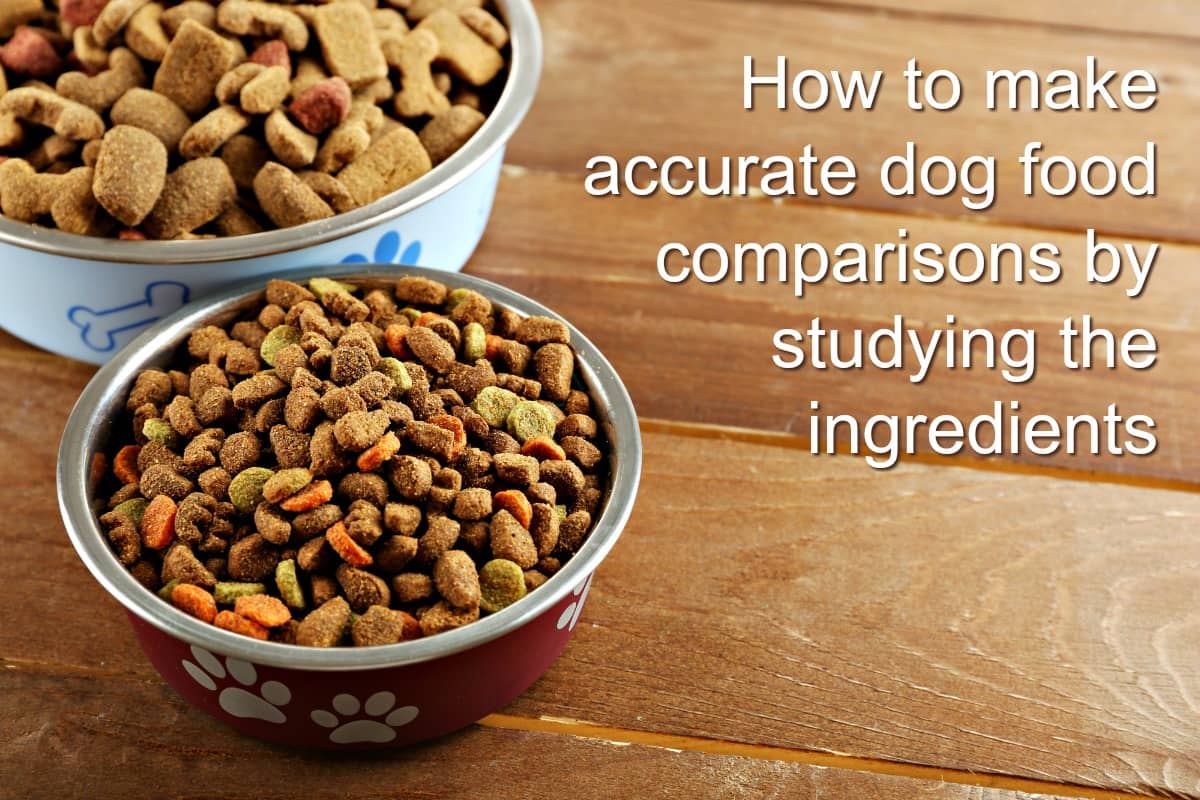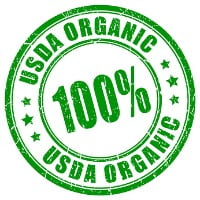FYI: If you buy something through a link on this site I may earn a commission - at NO extra cost to you.
Dog Food Comparison Charts
These easy-to-follow dog food comparison charts will help you compare a host of brands according to the most important factor.... ingredients!
With the huge selection of options available today, we could all do with a little bit of help choosing the right formula for our pets.
You can use this page to decode the confusing world of dog food labeling and to find out what ingredients are in a whole range of popular dog food brands.
I've taken a close-up-and-personal look at the nutrient profiles of twenty dry dog food formulas.
They're all quality brands, but two of them (Blue Buffalo and Canidae) have had issues with recalls and reports of dog illnesses being related to certain batches or formulas.
At this point no research has proven them to be poor choices, but I'd recommend doing some research yourself before choosing a food.
To see what I personally consider to be the best options, visit my Top 10 Best Dog Food Choices page.
The dog food comparison charts below will help you to make sure you're giving your dog the nutrition he needs, without all the 'stuff' that he doesn't.

*A growing puppy has completely different nutritional needs to those of an adult dog.
CLICK HERE to find out more about the very best puppy food choices.
Dog Food Comparison - Ingredients
When you're making a comparison between different dog food brands/formulas, you need to try to ignore the 'hype' and advertising slogans and look closely at the ingredients.
Every dog food bag has a lists of ingredients on it. You'll also find both nutrient and guarantee analysis of these ingredients. It can all look pretty confusing and to make things worse it's usually in tiny print!
The first three to five ingredients on the list make up the bulk of the food, so pay close attention to those first. Ideally you want to see wholesome, natural ingredients. Human-grade or organic is great.
But you don't want to see a lot of generic ingredients, the more specific the better. For example: 'chicken fat' is preferable to 'animal fat' .
This is because in the dog food world, 'animal' can almost literally mean ANY animal from roadkill to dead animals obtained from numerous sources. Ugh. SO look for a specific animal source for fat, meal and so on. Beef, chicken, lamb, venison... whatever, just as long as it's named!
You also don't want 'by-products', artificial additives or chemicals.
Here's a look at the first three ingredients in the dog foods I'm comparing on this page...
| Name of Food | 1st Three Ingredients | Vitamins & Minerals | DHA/Omega-3 |
|---|---|---|---|
| Precise Holistic Complete - Sm/Med Breed Adult | Chicken, chicken meal, ground brown rice | v | v |
| Precise Naturals - Chicken Meal & Rice Foundation | Chicken meal, ground brown rice, rice bran | v | v |
| Castor & Pollux Organix Adult | Organic chicken, chicken meal, ground brown rice | v | v |
| Avoderm Adult Lamb Meal & Brown Rice | Lamb meal, ground whole brown rice, ground whole white rice | v | v |
| Orijen Adult Dog | Fresh boneless chicken, chicken meal, chicken liver | v | v |
| Canidae All-Life Stages Formula (Dry) | Chicken meal, turkey meal, lamb meal | v | v |
| Canidae Grain Free Pure Lamb (Dry) | Lamb, turkey meal, chicken meal | v | v |
| Solid Gold Hund-n-Flocken Adult | Lamb, lamb meal, brown rice | v | v |
| Blue Buffalo Life Protection Chicken & Brown Rice | Deboned chicken, chicken meal, brown rice | v | v |
| Blue Buffalo Basics Adult Salmon & Potato | Deboned salmon, oatmeal, brown rice | v | v |
| Natural Balance Synergy Ultra | Chicken, chicken meal, brown rice | v | - |
| Natural Balance Vegetarian Formula | Brown rice, oatmeal, cracked pearl barley | v | v |
| Nature's Variety Prarie Formula - Chicken | Chicken, chicken meal, oatmeal | v | v |
| Nature's Variety Instinct Formula - Duck | Duck, turkey meal, salmon meal | v | v |
| Timberwolf Originals Black Forest Formula | Venison, brown rice, lamb | v | v |
| Timberwolf Ocean Blue Platinum Grain Free | Herring, salmon, spray-dried salmon | v | v |
| Wellness Complete Health De-boned Chicken | Deboned chicken, chicken meal, oatmeal | v | v |
| Wellness Simple Limited Ingredient Lamb & Oatmeal | Lamb, lamb meal, oatmeal | v | v |
| California Natural Lamb Meal & Rice Adult/Large Bites | Lamb meal, brown rice, rice | v | v |
| California Natural Chicken Meal & Rice Adult | Chicken meal, brown rice, rice | v | v |
A Word About AAFCO Regulations
Dog food manufacturers that adhere to the AAFCO (the Association of American Feed Control Officials) standards are allowed to put the wording 'a complete and balanced diet' on their food bags.
This
means that the food has been tested during feeding trials and is
considered a well balanced diet.... however, not ALL foods whose label
carries these words provide the nutrition that your dog needs!
To get all the information you need to understand AAFCO regulations, dog food ingredients, the different dietary needs of puppies, large breed dogs, small breeds and super-active dogs and much more, visit my About Commercial Dog Food page.
It's packed full of important information and will help you understand and interpret these comparison charts fully.
Dog Food Comparison - Nutrient %
When you're making dog food comparisons, it's not just what goes into the food that's crucial, the percentages and ratio of ingredients is important too.
There are certain minimums that any food should reach, and there are recommended maximums too.
Small breeds have different nutritional needs in comparison to the large/giant breeds.
Puppies have very specific and unique requirements, and you can find everything you need to know about these on my About Puppy Kibble page.
The following chart compares the same foods listed above, but this time it shows the percentages of nutrients in each formula.
The figures for Crude Protein, Crude Fat and DHA/Omega-3 fatty acids are the minimum each food should contain. Figures for Crude Fiber and Moisture are the shown as maximums.
Carbohydrate content is not included on dog food labels or packaging, it's something you need to work out for yourself.
The calorie content of the food is given as calories (written as Kcal) usually there's a measure for calories per kg and for calories per cup.
| Name of Food | Crude Protein | Crude Fat | Crude Fiber | Moisture | DHA/ Omega-3 |
Carb Content | Calories (Kcal) |
|---|---|---|---|---|---|---|---|
| Precise Holistic Complete Sm/Med Breed Adult | 26% | 16% | 3.5% | 10% | 0.53% | 38% | 427.5 Kcal/cup |
| Precise Naturals Chicken Male & Rice Foundation | 22% | 12% | 3.5% | 10% | 0.60% | 44% | 420.7 Kcal/cup |
| Castor & Pollux Organix Adult | 26% | 14% | 4.5% | 10% | 0.35% | 42% | 394 Kcal/cup |
| Avoderm Adult Lamb Meal & Brown Rice | 21% | 11% | 3.0% | 10% | 0.75% | 50% | 360 Kcal/cup |
| Orijen Adult Dog | 38% | 18% | 5% | 10% | 1.1% | 26% | 478 Kcal/cup |
| Canidae All Life Stages | 24% | 14.5% | 4% | 10% | 0.5% | 43.5% | 468 Kcal/cup |
| Canidae Grain Free Pure Lamb | 32% | 18% | 4% | 10% | 0.4% | 32% | 509 Kcal/cup |
| Solid Gold Hund-n-Flocken Adult | 22% | 10% | 4% | 10% | 0.75% | 50% | 365 Kcal/cup |
| Blue Buffalo Life Protection Chicken & Brown Rice | 24% | 14% | 5% | 10% | 0.4% | 44% | 378 Kcal/cup |
| Blue Buffalo Basics Adult Salmon & Potato | 20% | 12% | 6% | 10% | 1.0 | 50% | 375 Kcal/cup |
| Natural Balance Synergy Ultra | 28% | 16% | 5% | 10% | 0.5% | 38% | 410 Kcal/cup |
| Natural Balance Vegetarian Formula | 18% | 8% | 4% | 10% | 0.3% | 56% | 360 Kcal/cup |
| Nature's Variety Prarie Formula - Chicken | 22.5% | 13% | 6% | 10% | 0.40% | 46.5% | 420 Kcal/cup |
| Nature's Variety Instinct Formula - Duck | 35% | 20% | 5% | 8% | 0.5% | 29% | 443 Kcal/cup |
| Timberwolf Organics Black Forest Formula | 22% | 12% | 2.85% | 8.5% | 1.33% | 49% | 522 Kcal/cup |
| Timberwolf Ocean Blue Platinum Grain Free | 34% | 16% | 4% | 9% | 1.5% | 41% | 521 Kcal/cup |
| Wellness Complete Health De-boned Chicken | 22% | 12% | 4% | 11% | 0.4% | 47% | 407 Kcal/cup |
| Wellness Simple Limited Ingredient Lamb & Oatmeal | 21% | 12% | 4.75% | 11% | 0.75% | 48% | 406 Kcal/cup |
| California Natural Lamb Meal & Rice Adult/Large Bites | 21% | 11% | 2.5% | 10% | 0.3 | 50% | 439 Kcal/cup |
| California Natural Chicken Meal & Rice Adult | 21% | 11% | 2.5% | 10% | 0.3% | 50% | 430 Kcal/cup |
Choosing The Best Food For YOUR Dog
Once you've found out what's inside the dog food you're interested in, the next thing to do is to figure out if it's the right fit for your dog.
How To Estimate Carb Content
The carbohydrate content of any dog food isn't the most important thing you need to know. But if your dog has health issues which mean you're looking for a low-carb formula, it can help. There's a simple way to work this out from the info. you'll find on any dog food bag label...
Add up the figures (percentages) given for Protein, Fat & Moisture. Then if there's a figure for 'ash' add that in too. If there isn't one, just add 8%.
Now, subtract this total from 100 (%) and the number you're left with is the percentage of carbohydrates in that particular food.
There are a lot of things to take into consideration at this point. The most important being:
- Your dog's age
- His/her breed and size
- Activity level
- General health and specific health problems
Every pet food store (online and bricks-and-mortar) carries a dizzying array of dog food choices. Many of them are good, a lot of them aren't, but now you know what to look for so you can evaluate them yourself.
The very top, premium brands are more difficult to find offline, but the smaller, specialty pet stores often stock them, and Amazon.com carries 99.9% of them... at excellent prices.
Here's a very quick look at the different categories of dog food on a broad scale:
Small Breeds
Little dogs have metabolisms which run a-mile-a-minute, but they have tiny tummies. They eat only a little bit at a time, but they need to eat frequently to make sure that their blood sugars stay level and avoid hypoglycemia.
These little ones need a dog food which has a high calorie content (and is therefore energy-dense). They also benefit from above average levels of protein and fat.
Small-breed formulas are designed to fit these requirements, as well as being the perfect size for little mouths.
Large & X-Large Breeds
Large and giant breeds develop more slowly than the smaller ones and often don't mature until somewhere between 18 months and 2 1/2 years of age. This means that they need to stay with a 'Puppy Formula' for a lot longer.
Generally for a large breed adult you want a dog food formula that has between 22% and 30% protein, and 10% - 16% fat, with a slightly below-average calorie count.
Although there's debate over the necessity, and even the performance, of supplements in dog food, for large breeds added Chondroitin and Glucosamine may help prevent some of the joint issues most often seen in our big guys and gals.
Large-breed formulas aim to meet these needs and come in large kibble pieces for the bigger mouths.
Active/Performance Dogs
Working dogs and those who spend a lot of time out and about whether it's herding, agility, rescue work or whatever, have special needs when it comes to diet.
Look for a dog food that is calorie-dense to provide tons of energy, and choose one that has protein sources (eggs, muscle meat - basically a premium, lean meat - and organ meat are at the top of the list) that are easy for your dog to digest.
You can find food formulated specifically with the needs of active, high energy dogs.
Dogs With Health Problems
For all dogs, a good diet plays a big role in keeping Fido happy and healthy... and this applies equally to pooches who have health problems.
You may need to adjust your dog's diet to help him get the nutrition he needs without making any existing health issues worse. Below is a very brief overview of the general needs of dogs with specific problems - but please bear DISCUSS YOUR DOG'S DIET WITH YOUR VETERINARIAN BEFORE MAKING ANY CHANGES!
I'm not a veterinary professional and although the advice here is based on thorough research and the most recent scientific and veterinary conclusions, your dog is a unique individual and only your veterinarian knows what is best for him.
Pancreatitis or Obesity: Low to moderate levels of fat (between 9% and 12% is recommended).Average, or slightly above, protein levels (25% - 30% is about right). Calorie range between 250 and 350 Kcal per cup.
Diabetes: Look for a food with a 'low glycemic index' or 'low carb' formula. Grain free formulas also often fit the bill.
Heart Disease: You want a food that has a high quality source of protein, at a minimum level of 25%. Any of these supplements might also be helpful... Taurine, L-Carnitine, COQ10, B-Vitamins, Omega-3 Fatty Acids and Magnesium.
Gastro-intestinal Problems: For most GI problems, choosing a highly-digestible food is always going to be important. Look for complex carbs such as Sorghum (a grain) or barley, other sources of soluble fiber that is easy to digest also includes beet pulp, oats, fruits and vegetables. Premium high-quality protein. Prebiotic and probiotic supplements.
You can learn how to rate ANY Dog Food yourself according to the quality of it's ingredients on this page.....
Dog Food Comparisons & Analysis
you might also like...
- Home
- About Dog Food
- Dog Food Comparison
FTC Disclosure: Some pages on this site contain affiliate links. I may earn on qualified purchases.





